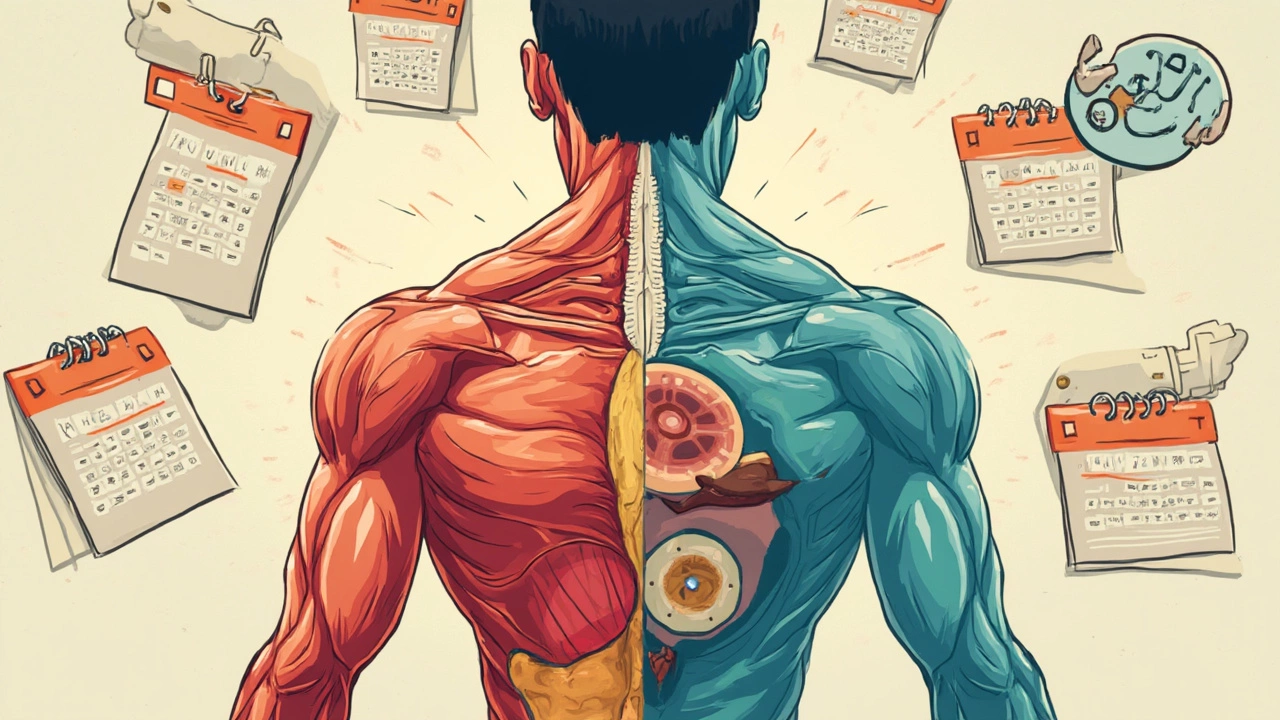Four weeks seems short when you’re staring in the mirror, wanting real change. But the truth is, your body can show impressive signs of progress in just a month—if you go about it the right way. No, you probably won’t walk out looking like a fitness model, but you will notice changes that can feel like a solid victory.
The catch? Most people either push too hard and crash, or barely try and wonder why nothing happens. What you do with those 28 days actually matters way more than your starting point. If you get the right mix of movement, food, and rest, you’ll start seeing your waistline shrink, your muscles tighten up, and your energy shoot higher—even before that four-week mark is up.
So, how do you make those changes count without fizzling out? It comes down to a few key strategies, and skipping the overhyped shortcuts or magic shakes. Real talk—consistency beats perfection. Let’s dig into what you can expect, how fast things really move, and how you can actually feel proud of the difference in your body by day 28.
- What Can Actually Change in 4 Weeks?
- Why Most People Overestimate (or Underestimate) Progress
- Science of Quick Gains: Fat Loss, Muscle, and Strength
- Your 4-Week Game Plan: Workouts and Nutrition That Stick
- Common Mistakes That Stop Progress Fast
- How to Keep Results Rolling After Week 4
What Can Actually Change in 4 Weeks?
Four weeks isn’t a magic window, but your body can actually do a lot in that short time if you stick to a plan. First, you’ll notice smaller changes: you might lose a few inches around your waist, your jeans could fit better, and simple things like walking up stairs or doing push-ups get way easier. This isn’t just wishful thinking—real research backs it up.
If you follow a well-designed workout and nutrition plan, here’s what’s usually possible in 28 days:
- Fat loss: With smart eating and regular workouts, dropping 4–8 pounds in a month is totally doable for most people. That’s about 1–2 pounds a week, which doctors say is both safe and realistic.
- Muscle tone: Newer lifters see clear signs of "muscle wake-up"—meaning muscles get firmer and sometimes even look a bit bigger, mostly from better glycogen storage and less water weight.
- Strength: Your body gets better at using existing muscle. Gains come fast at first—sometimes doubling the number of push-ups or squats you can do by week four.
- Energy and mood: You’ll likely notice better sleep, improved mood, and more energy throughout the day. This happens faster than you might expect after starting a regular program.
Check out what can shift in a typical four-week period:
| Change | Average Result (4 Weeks) | Who Noticed It |
|---|---|---|
| Pounds lost | 4–8 lbs | Most beginners/intermediate |
| Waist size lost | 1–2 inches | Majority of consistent folks |
| Push-ups increased | 2× starting reps | Beginners |
| Energy improvement | Noticeable within 2 weeks | Almost everyone |
Keep in mind, most of these quick changes come from tweaks to daily habits rather than big overhauls. You won’t reach your final "after" picture in four weeks—those before/after shots on social media often hide months of effort. But if you want real talk on body transformation, a month is enough time to notice better mood, more strength, looser clothing, and a heck of a confidence boost when you look in the mirror.
Why Most People Overestimate (or Underestimate) Progress
It’s crazy how often people get fooled by expectations in the first month. Either they think a body transformation is about turning into someone else overnight, or they believe nothing will change even if they try. Both are wrong, and there are real reasons for it.
First up, a lot of “before and after” photos on social media only tell half the story. Lighting, filters, and flexing make changes seem dramatic. You might think four weeks is all you need for magazine-level results. In reality, your body starts to shift from the inside first — like your metabolism getting faster, or your muscles getting used to new moves. Sometimes, the mirror takes a while to catch up.
On the flip side, underestimating progress is just as common. Maybe you step on the scale and see only a small drop. Or you measure your waist and feel like nothing budged. Guess what? Most first-timers can lose 4-8 pounds in the first month if they combine good nutrition and steady workouts. Even building a pound or two of lean muscle is solid progress for a newbie.
If you want some hard numbers, check out how fast these changes really show up:
| Change | Average 4-week Result |
|---|---|
| Fat loss | 4-8 lbs (with calorie deficit) |
| Muscle gain (beginner) | 1-2 lbs |
| Body fat % drop | 1-2% |
| Strength (example: squat) | Up to 20% increase |
So, what messes with our heads? The old scale game is a big one. Muscle weighs more than fat, so sometimes people get leaner but stay the same weight, which can feel frustrating unless you track more than just pounds. Water weight can swing up and down by a few pounds in days, too, especially if you eat salty or carb-heavy meals—or hit a tough new workout.
A better way to notice progress is to use lots of tools: take weekly progress photos in the same light, use a tape measure for your waist or hips, and jot down how your clothes fit. Most people spot real difference at week two or three—so long as they stick to their plan instead of waiting on an overnight miracle.
Science of Quick Gains: Fat Loss, Muscle, and Strength
Everyone talks about quick results, but what’s actually happening in your body during a four-week hustle? Let’s keep it simple. In the first week or two, most folks see the scale drop fast. Sorry to burst the bubble, but the first few pounds? That’s usually water weight. Your body stores carbs with water, so when you eat fewer carbs, you lose some water—giving you a quick win, but not real fat loss yet.
Real fat loss starts to tick up when your body runs a calorie deficit. If you eat about 500 fewer calories per day than you burn, you can drop around 1-2 pounds of fat per week. Not miracles, just science. Here’s a quick breakdown of what you can realistically expect in 28 days if you train and eat smart:
| Area | Week 1 | Weeks 2-4 |
|---|---|---|
| Fat loss | Mostly water, little fat | 1-2 pounds fat/week |
| Muscle growth | Muscle activation, small gains | Up to 1-2 pounds/month* |
| Strength | Fast gains (nervous system) | Continued steady improvements |
*Total muscle gain depends on genetics, diet, and training type. Beginners see faster changes because their bodies are not used to lifting or new moves.
When it comes to muscle and strength, those first few weeks are wild. Your muscles learn to contract better—so you’ll feel a lot stronger, even if the muscles don’t look bigger yet. You can thank your nervous system for that trick! Actual muscle growth is slower. Most new lifters might grow 1 or 2 pounds of muscle in a month, and that’s with good sleep, solid eating, and smart workouts.
So what does a smart body transformation routine look like for quick gains?
- Mix resistance training (like weight lifting or bodyweight moves) at least three times a week.
- Include cardio—a couple sessions per week burns extra calories and boosts heart health.
- Prioritize protein at every meal to feed your muscles.
- Get enough sleep—seven hours or more is best for muscle repair and fat loss.
Don’t forget, women and men gain and lose body fat a little differently. Also, if you’re brand new to working out, your results will often show up faster in those first weeks. The most important thing? Don’t compare yourself to online models or influencers—real bodies move at their own speed.

Your 4-Week Game Plan: Workouts and Nutrition That Stick
If you’re looking for a realistic kickstart, here’s what a smart four-week fitness plan actually looks like. Sticking to the basics is way more effective than jumping on every trending workout or radical diet.
The first thing: you need both consistent workouts and good nutrition. Ignore one, and results will stall. Split your week between strength training, cardio, and rest. Aim for at least three strength sessions and two cardio days each week. Don’t go all-in on hardcore routines if you’re just starting—injuries and burnout kill progress fast.
- Strength Training (3x/week): Focus on big moves like squats, lunges, push-ups, and rows. Beginners can stick with bodyweight or simple dumbbells.
- Cardio (2x/week): Try brisk walking, cycling, or HIIT for 20-40 minutes. Mix it up to keep things fresh.
- Active Recovery (1-2x/week): Yoga, stretching, or easy walks help your body recharge. Don’t skip your rest days—muscles grow when they recover.
For food, you’re not looking for a crash diet. You want foods that fill you up and fuel your workouts. Simple rule: every meal should have a decent protein source, some veggies, and either a whole grain or healthy fat. If you like tracking, aim for about 1.2 to 1.6 grams of protein per kilo of bodyweight. That actually helps with muscle gain and keeps hunger down, according to research published in 2022.
Watch out for sneaky calories—sweet drinks, processed snacks, and massive portions. Most people underestimate how much they eat, especially with sauces and extras. If you want to see clear results, fill half your plate with veggies and keep snacking in check. Drink more water; it really does make a difference.
| Workout Days/Week | Average Protein Needed (g/day)* | Daily Water Goal (liters) |
|---|---|---|
| 4-5 | 80-120 | 2.5-3 |
| 2-3 | 60-90 | 2-2.5 |
*Based on bodyweight 50-75kg and current research for fitness nutrition.
Above all, stay consistent. Your body needs about ten days just to notice changes in routine, so don’t get discouraged if you don’t see big results right away. The body transformation you want comes from stringing together little wins—showing up, eating a little better, and not giving up.
Common Mistakes That Stop Progress Fast
If you feel stuck before you even finish your first month, you’re probably falling for some classic mistakes. Four weeks go by in a flash, but it’s enough time to run into roadblocks—if you don’t watch out. Let’s keep it real: most people mess up by chasing quick fixes or not paying attention to the boring basics. Here’s what usually trips people up and how to sidestep those traps.
- Doing Everything at Once. You decide to work out every day, cut all carbs, and swear off sugar forever—on a Monday. By the weekend, you’re completely burned out. Real change sticks when you add a couple of habits at a time instead of flipping your entire life upside down overnight.
- Skipping Rest Days. If you hammer your body with hard workouts but never give it a break, you hit a wall fast. Your muscles get sore, tired, and cranky. Rest is when you actually build new muscle and get stronger. No rest? No real progress.
- Not Eating Enough. A lot of people slash calories, thinking less food means faster fat loss. But your body needs fuel, especially when you crank up the intensity. Too little food slows your metabolism and makes you feel like quitting.
- Copying Crazy Internet Workout Challenges. Doing 1,000 squats a day or some random influencer’s “miracle” routine might look cool on TikTok, but it’s not made for you. Most of these plans aren’t backed by science and just leave you sore or disappointed.
- Tracking Only the Scale. If you rely on the number between your feet, you’ll miss out on real wins—like how your clothes fit, how strong you feel, or how much more energy you have. The scale doesn’t know if you gained muscle or dropped water weight, so don’t let it rule your mood.
- Not Having a Plan. Wandering into the gym (or pressing play on a random YouTube video) without a set goal is a fast track to nowhere. Having a simple routine, whether that’s a basic full-body workout three times a week or a meal plan with lots of protein, keeps you focused.
Want results that last more than a month? Lock in a couple of solid habits and stick with them. Skip the buzzy trends, focus on your body transformation basics, and don’t ignore what your body’s telling you. You’ll sidestep most of the things that make people quit, and that’s when the real changes happen.
How to Keep Results Rolling After Week 4
This is where most people lose steam. Honestly, finishing four weeks strong feels amazing, but your body needs new challenges, not just repeats. If you want those changes to stick, you need to tweak your plan a bit—otherwise, the progress stalls fast and motivation tanks.
The number one trick? Don’t stop tracking your habits after the first month. Folks who stick with workout logs or simple food journals keep their body transformation on track way longer. A small 2022 study from the University of North Carolina found that people who tracked their progress in a visible way stayed consistent for at least three months, not just four weeks.
Here’s what really helps keep results coming in, even after your first 28 days:
- Mix up your workouts: After a month, your muscles get used to the same routine. Change the exercises, try new classes, or add intensity by increasing weight or reps every two weeks.
- Keep your food plan flexible: Eating the exact same meals gets old. Swap one or two meals a week with new healthy recipes or experiment with different veggies and proteins. This keeps your nutrition balanced and boredom at bay.
- Stay accountable: Whether it’s a gym buddy, an online group, or a weekly check-in with yourself, having some sort of accountability makes a huge difference. People are 65% more likely to reach their goals with an accountability partner, according to a study from the American Society of Training and Development.
- Don’t ditch sleep and recovery: Your body is still repairing and building muscle. Adults who get less than 6 hours of sleep see slower fat loss and more muscle loss, shown in research published by the Annals of Internal Medicine.
It’s also helpful to set mini-goals after you finish a 4-week challenge. Instead of obsessing over the scale, focus on goals like running a faster mile, doing more push-ups, or prepping meals on Sunday. These little wins keep your excitement high and prevent old habits from sneaking back.
| Habit | Why It Works | Tip to Make It Stick |
|---|---|---|
| Swap Up Workouts | Prevents plateaus; muscles keep growing | Change one exercise each week |
| Food Journal | Keeps nutrition honest | Write daily or use an app |
| Accountability | Higher chance of sticking to goals | Check-in weekly with someone |
| Mini-Goals | Builds long-term motivation | Set new one every two weeks |
The four-week mark is just the start—treat it like a testing ground, not the finish line. With a few tweaks and some solid tracking, real body transformation is something you can keep building for months, not just a few weeks.





